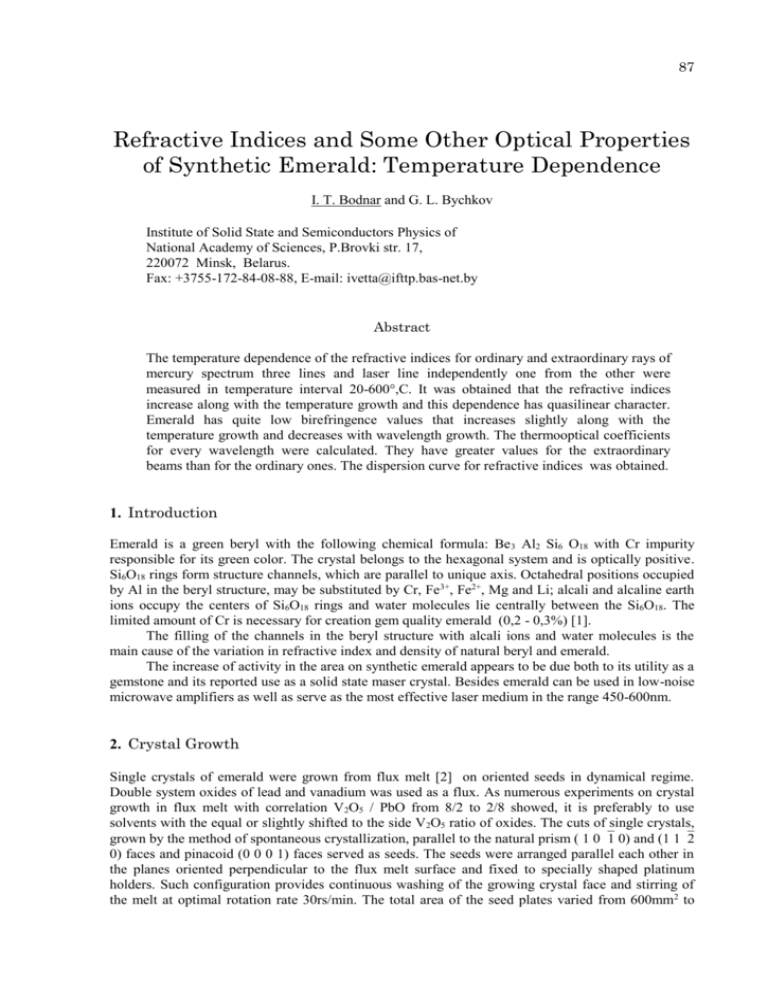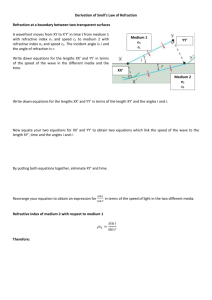Refractive Indices and Some Other Optical Properties of Synthetical
advertisement

87 Refractive Indices and Some Other Optical Properties of Synthetic Emerald: Temperature Dependence I. T. Bodnar and G. L. Bychkov Institute of Solid State and Semiconductors Physics of National Academy of Sciences, P.Brovki str. 17, 220072 Minsk, Belarus. Fax: +3755-172-84-08-88, E-mail: ivetta@ifttp.bas-net.by Abstract The temperature dependence of the refractive indices for ordinary and extraordinary rays of mercury spectrum three lines and laser line independently one from the other were measured in temperature interval 20-600,C. It was obtained that the refractive indices increase along with the temperature growth and this dependence has quasilinear character. Emerald has quite low birefringence values that increases slightly along with the temperature growth and decreases with wavelength growth. The thermooptical coefficients for every wavelength were calculated. They have greater values for the extraordinary beams than for the ordinary ones. The dispersion curve for refractive indices was obtained. 1. Introduction Emerald is a green beryl with the following chemical formula: Be 3 Al2 Si6 O18 with Cr impurity responsible for its green color. The crystal belongs to the hexagonal system and is optically positive. Si6O18 rings form structure channels, which are parallel to unique axis. Octahedral positions occupied by Al in the beryl structure, may be substituted by Cr, Fe3+, Fe2+, Mg and Li; alcali and alcaline earth ions occupy the centers of Si6O18 rings and water molecules lie centrally between the Si6O18. The limited amount of Cr is necessary for creation gem quality emerald (0,2 - 0,3%) [1]. The filling of the channels in the beryl structure with alcali ions and water molecules is the main cause of the variation in refractive index and density of natural beryl and emerald. The increase of activity in the area on synthetic emerald appears to be due both to its utility as a gemstone and its reported use as a solid state maser crystal. Besides emerald can be used in low-noise microwave amplifiers as well as serve as the most effective laser medium in the range 450-600nm. 2. Crystal Growth Single crystals of emerald were grown from flux melt [2] on oriented seeds in dynamical regime. Double system oxides of lead and vanadium was used as a flux. As numerous experiments on crystal growth in flux melt with correlation V2O5 / PbO from 8/2 to 2/8 showed, it is preferably to use solvents with the equal or slightly shifted to the side V 2O5 ratio of oxides. The cuts of single crystals, grown by the method of spontaneous crystallization, parallel to the natural prism ( 1 01 0) and (1 12 0) faces and pinacoid (0 0 0 1) faces served as seeds. The seeds were arranged parallel each other in the planes oriented perpendicular to the flux melt surface and fixed to specially shaped platinum holders. Such configuration provides continuous washing of the growing crystal face and stirring of the melt at optimal rotation rate 30rs/min. The total area of the seed plates varied from 600mm2 to 88 2000mm2 depending on the crucible volume and the flux melt mass. The optimal experiment cycle lasted, in the average, for 3-4 months. The best single crystals grown in the experiment were almost perfect in terms of the optical parameters weighting as much as 150 carats. 3. Experimental Refractive indices of the ordinary and extraordinary rays were measured during continuous heating or cooling of prisms cut out from crystals in such a way that the optic axis was parallel to the prism edge and the light beam propagated through the prism perpendicular to the optical axis. The size of prism was nearly 6x6x7x4mm, where 6 and 7mm was the sides of the triangular basis of prism and 4mm was its height. The least deviation method is used. He-Ne laser and a mercury lamp were sources of light. The temperature dependence of the refractive indices of mercury spectrum three lines and laser line independently one from the other was measured. The measurements were performed for the next wavelengths of mercury emission lines: violet, 4647Å; green, 5461Å; yellow, 5852Å and for laser line, 6328Å with a step 4- 5 using a GS-5 goniometer-spectrometer. The heating (cooling) rate did not exceed 0,5K/min and the sample temperature was measured with a platinum-rhodium thermocouple with an accuracy of 0,1K. 4. Results Temperature dependences of refractive indices for ordinary and extraordinary rays at different wavelenghts are shown in Fig. 1. 1,585 n7 Refractive index 1,580 n8 1,575 n5 n3 n1 n6 n4 n2 1,570 1,565 1,560 0 100 200 300 400 500 Temperature, 0C Fig. 1 Temperature dependence of refractive indices of ordinary and extraordinary rays for four different wavelengths. Curve n1 belongs to ordinary rays of red laser line, and curve n2 belongs to extraordinary rays of red laser line; curves n3, n5 and n7 reflect the temperature dependence of refractive indices of ordinary rays for green, yellow and violet lines of mercury spectrum, and curves n4, n6 and n8 are the temperature dependence of refractive indices of extraordinary rays for green, yellow and violet lines of mercury spectrum. 89 Birefringence It is obtained that the refractive indices increase along with the temperature growth and this dependence has quasilinear character. Emerald possesses the following refractive indices at the room temperature: for = 464,7nm ne = 1,5770; no = 1,5731; for = 546,1nm ne = 1,5673; no = 1,5635; for = 585,2nm ne = 1,565,6; no = 1,5619; for = 632,8nm ne = 1,5646; no = 1,5612, where no and ne - ordinary and extraordinary refractive indices. We should note that emerald refractive indices just slightly change along with the temperature growth. The temperature dependence curves (images of collimator slit) for all the spectral lines are practically parallel. That means that the thermooptical coefficients are almost the same for all wave lengths of both ordinary and extraordinary rays. They are slightly greater for the extraordinary rays than for the ordinary ones, 1,45 – 1,5 10-5 and 1,2 – 1,4 10-5 accordingly. Emerald has a very low birefringence value which does not change while temperature grows. Fig. 2 shows the graph of the temperature dependence of the birefringence. 0,0044 0,0042 0,0040 0,0038 0 200 400 Temperature, 600 0C Fig. 2 Temperature dependence of birefringence ( ne-no ) value, where no - refractive index of ordinary rays and ne- refractive index of extraordinary rays. The birefringence value does not practically change while the wave length increases, i.e. the birefringence dispersion is absent. At the time the dispersion for refractive indices appears normal because refractive indices decrease along with wave length incease, Fig. 3. 1,578 1,576 1,574 n e 1,572 1,570 1,568 1,566 1,564 450 500 550 600 Wavelengths, nm Fig. 3 Dispersion of the extraordinary rays refractive index. 650 90 5. Conclusion We should note that emerald's behaviour is quite similar to one of the inert gases or noble metalls i.e. it does not practically interact with external medium if compared to other crystals such as ferroelectrics, nonlinear crystals, semiconductors and quartz. The slight increase of refractive indices monitored while temperature increases is likely to be caused by the thermal expansion of the lattice. We believe the main particularity of this crystal is the absence of any particularities in the optical properties measured by us. We can consider that absence as the main positive attraction of emerald upon its employing in dirreferent optical devices as the sinthetical emerald is much cheaper than the natural one. References [1] E. M. Flanigen, D. W. Breck, N. R. Mumbach, and A. M. Taylor, “Characteristic of synthetic emeralds,” The American Mineralogist, Vol. 52, May-June 1967. [2] S. N. Barilo, G. L. Bychkov, L. A. Kurnevich, N. I. Leonuk, V. P. Mikhailov, S. V. Shiryaev, V. T. Koyava, and T. V. Smirniva, “Controlled crystallization of emerald from the fluxed melt,” Journal of Crystal Growth, Vol. 198/199, pp. 716 - 722, 1999.








